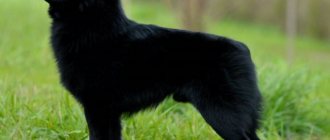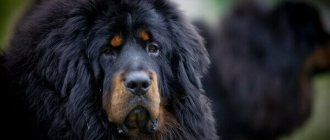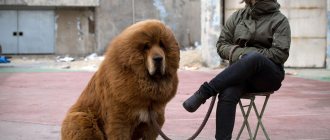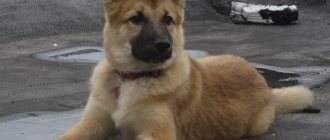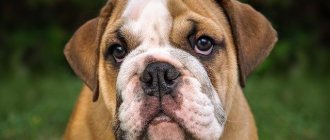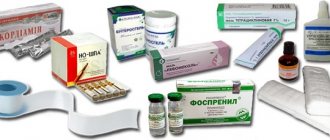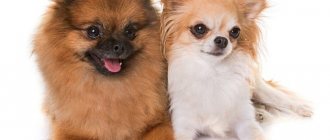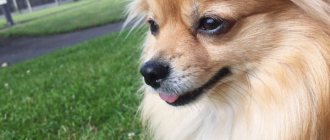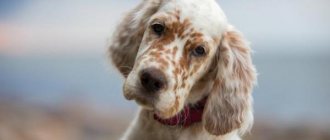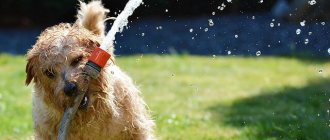The International Cynological Federation included all types of Spitz in group 5 and divided them into sections depending on their origin, appearance, and purpose. This article is devoted to an overview of European, Asian Spitz and individual Spitz-types from other sections.
- Akita.
European Spitz
Spitz dogs were recognized as direct descendants of the oldest fossil dog, the so-called “peat” or “swamp” dog. Presumably these were the first domesticated dogs in Central Europe.
The section of European Spitz included 2 breeds with common external characteristics:
- wedge-shaped head;
- square body;
- neat narrow muzzle;
- thick double coat with straight, hard hair and soft fluffy undercoat;
- tail up and curled.
Within the breeds, varieties have developed with their own standards of size and color.
German Spitz
The breed was formed in the Middle Ages in Germany. Back then, Spitz dogs were kept in villages as watchmen and security guards. Practical farmers kept large dogs on the farm. The small ones were discarded, disparagingly called miniatures - dwarfs.
When the charming animals were noticed in aristocratic circles, selection began to reduce their size and improve their appearance. Gradually, 5 types of German Spitz were formed. In the FCI they have a general standard with clarifications of sizes and colors:
- Wolfspitz - Keeshond. The largest German Spitz. Height at withers 43 – 55 cm. Wolf color: gray coat with a silver tint, black tips, darkening on the muzzle and ears.
Wolfspitz - The Wolf Spitz is named for its color.
- Grossspitz. Height 40 – 50 cm. Solid colors – juicy dark brown, white, black.
Grossspitz.
- Mittelspitz. Height at the withers is 30 - 40 cm. To the previous colors are added orange, silver-gray, cream, black and tan, white with plain colored spots - party color.
Mittelspitz orange.
- Kleinspitz. Height 24 – 30 cm. Colors like an average Spitz.
Kleinspitz cream.
- Miniature Spitz or Pomeranian. In the latest version of the 2022 standard, the permissible height of oranges has been increased by a couple of centimeters - the lower limit is 18 cm, the upper limit is 24 cm.
Zwergspitz.
Breeders tried to improve Pomeranians by infusing the blood of other miniature dogs, so unofficial subtypes appeared among them:
- “Chantelles” Classic Pomeranians with a moderately elongated muzzle and high-set triangular pointed ears.
- “Bears” With a short muzzle, small, slightly rounded ears.
Both types can be born in the same litter, but during puppyhood it is impossible to determine how the puppy will grow up.
Dog handlers and conscientious breeders do not divide Pomeranians into “foxes” and “bears” and do not undertake to predict what shape and size the muzzle and ears of an adult Pomeranian will be.
German Spitz dogs are extremely loyal companions. Regardless of size, they quickly become attached to their owner and family. They easily adapt to any conditions and train well. They do not suffer from genetic diseases, rarely get sick, and live long.
Volpino Italiano
Original Italian Spitz. The breeding center was Florence, where Volpino was kept both in palaces and in the homes of common people. Decorative fluffy dogs were loved by Italian Renaissance painters.
Volpino means “chanterelle” in Italian.
Volpino's height is 25–30 cm. The coat is white, rarely red or champagne-colored. Friendly, cheerful dogs form a strong bond with their owner. They gladly respond to invitations to play and love children. They are suspicious of strangers, barking to warn of danger.
Interesting: Mini Spitz and other small white dogs.
Alaskan Malamute
Originally bred for tasks such as hunting polar bears or pulling heavy sleds, the Malamute is today a popular dog breed among families and people with active lifestyles.
Between their fluffiness and huge paws and cheeks, these pups look like they'll grow into elegant white and gray bears. The dog needs a bath every 6-8 weeks, and its long coat with a thick undercoat needs to be brushed daily or at least every other day. Thick and moderately hard coat does not require cutting. The color of Malamutes is often gray to black or red.
Finnish Spitz
A breed with complicated origins. The selection took place simultaneously in Finland and Karelia. Gradually, 2 livestocks were formed with subtle differences and one standard - Karelian-Finnish huskies and Finnish spitzes.
The height of Karelian-Finnish cats is 42 – 47 cm. The color is bright red.
In January 2022, the Russian Canine Federation officially declared the Karelian Laika an independent breed. Dog handlers clarify: huskies are working hunting dogs, while Spitz dogs have more developed qualities as companions.
Finnish Spitz and Karelian Laika are all-round hunters of upland birds, ungulates, and fur-bearing animals. They are true masters of “artistic” barking. When hunting, they signal the found prey with a mass of intonations: from a quick, abrupt bark to a loud bark and sounds similar to yodelling.
Disqualifying faults
The breed standard, approved by the International Canine Federation, voices the characteristics by which the purebred of an animal is determined. Dog handlers consider deviations from the points as shortcomings or disqualifying defects. Their severity is determined by the degree of deviation from the norm and the negative impact on the health of the Pomeranian.
Serious disadvantages of miniatures include:
- anatomical defects;
- irregular head shape (apple-shaped or flat);
- absence of incisors;
- bulging eyes;
- light iris;
- flesh-colored lips, nose, eyelids;
- lack of dark markings in wolf-colored oranges.
The list of disqualifying faults for Pomeranians includes:
- open fontanel;
- malocclusion (crossbite, underbite, overbite);
- semi-erect ears;
- turning of the eyelids;
- anomalies in behavior (aggression, cowardice);
- white markings on dogs of a single color;
- cryptorchidism in males.
Samoyed dog
An indigenous breed of the Russian North and Siberia. Shaggy dogs were bred by Samoyed tribes. Animals transported cargo, slept in dwellings, warming people with their warmth.
The Samoyed dog is often called the Arctic Spitz.
Compact, elegant Samoyeds grow up to 50–60 cm. Their coat is truly “polar”: thick, dense, shiny, snow-white or cream in color. The structure and location of the eyes, slightly raised corners of the lips make the expression of the muzzle friendly, smiling and good-natured.
Samoyed smile.
The character of Samoyeds is open and friendly. They love to communicate, “talk,” conveying a lot of emotions with their voices. Due to their too good-natured attitude towards people, they will not become good watchmen and security guards.
General signs
Spitz and primitive dogs are characterized by a dry and lean exterior. Moreover, it is natural, natural, and not cultivated, like greyhounds. Their body is shaped this way by thousands of years of struggle for survival.
Spitz-type and primitive dogs are usually silent. They practically do not bark, but only sometimes grumble. They have well-developed necessary sense organs: vision, hearing and smell, excellent immunity, increased levels of red blood cells in the blood, etc.
These dogs, as a rule, live in packs; within each pack there is its own system of subordination and a leader, to whom Spitz and primitive dogs strictly obey.
All Spitz and primitives have high intelligence, which developed as a result of the constant struggle for their existence, as well as the performance of certain work: hunting, moving cargo in harness, protecting people, material assets, etc.
Swedish Lapphund
Scandinavian dog with the appearance of a typical Spitz. The animals were bred by the indigenous people of Northern Europe, the Sami or Laplanders.
The second name for the Swedish Lapphund is Lapland Spitz.
Height at the withers is 40 - 50 cm. The only color is solid black, less often with brown inclusions. Initially, Swedish Lapphunds helped hunters and reindeer herders. Modern Lapland Spitz are excellent family dogs and universal companions.
Newfoundland
A gentle giant, the Newfoundland is a brave and intelligent working dog. This is primarily a family companion, and will also become a partner for a traveler or tourist.
Huge paws, fluffy fur, round dark eyes, plump cheeks - a Newfoundland puppy can pass for a black bear. Brown and black and white Newfoundlands are also cute. The coat requires constant care; the dog must be bathed 2-4 times a month with special products and combed 3-4 times a week with a stiff-bristled brush. The Newfoundland's haircut should not be radical; its thick coat protects it from cold in winter and from heat in summer.
Icelandic Sheepdog
Medium sized Northern Herding Spitz. Height at the withers is up to 46 cm. The coat is short or semi-long. Colors: red, grey, chocolate, tri-color with white collar, socks, shirt front, tip of tail.
In their homeland, Icelandic Shepherds are readily adopted as companions. These are sociable, inquisitive, good-natured, but noisy animals. Due to their pronounced territorial instinct, they like to bark if they suspect border violations. They get along well with children and avoid conflicts with pets.
The breed is rare outside of Iceland, but the herding Spitz is growing in popularity.
English bulldog
The English Bulldog is a short-haired breed of dog that is famous for its courage and devotion to its family. Their coats come in a variety of colors, but there are also dogs with completely white coats. The Bulldog has a medium body size and is also considered an excellent dog breed for apartment living.
This breed has a calm, balanced and kind character, and, as a rule, does not create problems for its owners. However, raising a pet still needs to be done.
Asian types of Spitz and related breeds
The Asian Spitz section included 12 breeds. Some of them developed separately, although the characteristic features of a Spitz can be traced in their appearance - straight double coat, wedge-shaped head, curled tail. European Spitz dogs participated in the selection of individual Asian Spitz-type dogs.
Akita Inu
The largest of the 6 native Japanese dogs. There were periods in history when they hunted bears and took part in dog fights. Now the Akita Inu has only one purpose - as a companion dog.
Akita came to world fame after the release of the film Hachiko.
The height of the Japanese Akita is 61 – 67 cm. Basic colors:
- red-fawn;
- white;
- brindle;
- sesame - a mixture of red, black, white hair.
The main color is complemented by urajiro - light symmetrical markings on the neck, cheeks, belly, chest, inner surface of the legs, and the bottom of the tail.
Akita Inu puppy.
The standard describes the Akita Inu as a reserved, loyal, receptive and obedient dog.
Kai
An ancient breed that formed on the Japanese island of Honshu in the Kai province. The animals were bred for hunting in a separate area surrounded by a chain of mountains, so the pristine nature of the breed was preserved.
The height of Kai Inu is 48 – 53 cm.
Puppies are born with a uniform coat. Contrasting tiger stripes gradually appear. Because of its color, the kai received a second name - brindle dog.
Kai puppy.
Kais are kept as hunters and companions. Their independent nature prevents them from being obedient pets. Proud dogs recognize and obey only one owner. The rest are treated aloofly, but without aggression. They are rare outside their homeland, although they are gaining popularity in Canada and the USA.
Kishu
An indigenous Japanese breed that began to form 3 thousand years ago in the Kishu province.
The height of kishu is 46 – 52 cm. The color is white, less often red and sesame.
Kisya is bred for hunting wild boar and bear. They are kept as guard dogs and companions. The standard describes the Kishu Inu as a hardy, noble, simple-minded, loyal and obedient dog.
Shiba Inu
The smallest of the indigenous Japanese breeds, Shiba Inu means small dog. Height does not exceed 40 cm. Standard colors: red, black with light tan and sesame.
Shiba Inu with a puppy.
Initially, compact shibas were bred for hunting birds in bushes. Nowadays they are often kept as companions. According to the owners, they have a friendly but difficult character. Shibas are capricious, so raising a pet requires a firm hand.
The one on the right is not a puppy. This is a mini Shiba and a standard one.
Since 1950, breeders began breeding mini Shiba Inu under 34 cm in height - mameshiba. However, cynological organizations do not approve of the “reduction” of the breed, considering it a violation of health and temperament.
Shikoku
Another indigenous Japanese breed, bred on the island of the same name. Height at withers 46 – 52 cm. Basic colors: sesame with an equal number of black, bleached and red hair, black-sesame, red sesame.
For Russia, Shikoku is a rare breed. Nurseries operate in Saratov and Vladivostok. This is what the RKF standard says about the Shikoku temperament.
Hardy, sensitive dog. The character is open and direct, the behavior is very wary. She is obedient to her owner. Gambling hunter.
Hokkaido or Ainu
The ancestors of Hokkaido came to the Japanese island of the same name along with the first people - the Ainu. Dogs served as universal assistants: guards, shepherds, hunters, fishermen.
Hokkaido height 48 – 51 cm. Colors:
- ginger;
- white;
- black solid or with tan;
- fawn with dark tips;
- brindle.
According to the standard, Hokkaido are brave, hardy, intelligent, with a lively temperament and a simple-minded character. They have an innate sense of direction: Ainu are able to return to their owner, being hundreds of kilometers from home.
Since 1928, 6 indigenous breeds of Japan have been protected by the Nippo Association, a club for the protection of indigenous Japanese dogs. And in the 30s, the Japanese government declared them a natural monument and national treasure.
American Akita
The breed began to take shape after the Second World War, when the American military brought Japanese Akita puppies home. During selection, they were crossed with German shepherds and English mastiffs.
American Akitas are larger than Japanese ones.
These are large, furry dogs, 61–71 cm tall. They have wider bones, a more voluminous muzzle, and almost any color is allowed by the standard.
According to owners' reviews, the American Akita is docile, receptive, and silent. Easy to train, does not show aggression towards the owner, family, or strangers. However, in an extreme situation he will be able to protect his family.
Korean Jindo or Jindo
Nothing is known about the origin of the Jindo, but there is no doubt about the fact that dogs have lived for centuries on the South Korean island of Jindo.
Jindo's height is up to 55 cm.
Jindo is a one-owner dog; he even accepts food only from the owner’s hands. In Korea, the story of a Jindo named Baekku is popular. The 83-year-old owner sold the pet to a new owner, who took the animal to another city 300 km away. After 7 months, tired and exhausted, Pekku returned to her previous owner.
Thai bangkaew
The breed first appeared in the Bangkaew settlement in north-central Thailand. The roots can be traced back to the first generation: the white and black bitch of a local clergyman and a wild jackal-shaped dog. The FCI recognized “Thais” only in 2011 and included Asian Spitz dogs in the section.
The coat is semi-long with decorative hair on the chest and tail. The color is white with black or colored spots. The standard describes the Bangkaew as an agile, intelligent, obedient dog that is easy to train.
Chow chow
Hairy chows appeared in China more than 2 thousand years ago, but spread throughout the world in the 1920s. They are compact, robust dogs related to the Scandinavian Spitz and Mastiff.
Chow seems large, in fact his height is 46 – 56 cm.
The breed has 2 types of coat: semi-long with rich feathering on the neck and hips and short plush, not adjacent to the body. The colors are monochromatic - red, white, cream, black, blue and cinnamon - from “café au lait” to cinnamon color. The breed's characteristic feature is a blue-black tongue.
A new fashion trend has spread in China. Chow chows are cut and dyed to resemble a bamboo panda bear. The procedure lasts 2 hours, and the “hairstyle” lasts 6 weeks.
Chow panda is not a species or color, but the result of a groomer’s work.
Chows are calm companions, vigilant watchmen. They behave with self-esteem, sometimes somewhat arrogantly.
Eurasier
The Eurasian Spitz was bred by German breeders J. Wipfel and S. Baldamus. Dog handlers decided to get a visually attractive dog of the northern type with an impeccable character, suitable for home keeping. To do this, they crossed a Chow Chow and a Wolfspitz, and later added Samoyed blood.
The height of the Eurasier is 48 – 60 cm. Colors are any solid except white and liver, zoned gray.
Eurasiers are companion dogs adapted for living in cities and rural areas. Thanks to their stable psyche, they behave in a balanced, confident manner, without unnecessary noise. The Eurasian Spitz does not have a developed hunting instinct; the main thing for him is his owner and family.
Japanese Spitz
The breed was created by Japanese cynologists in the 1920s and 30s based on imported white European and American Spitz dogs.
The Japanese Spitz is a snow-white dog 30 – 38 cm tall.
Japanese dog handlers sought to develop an exemplary home companion for families with children and the elderly. The result of painstaking breeding work was obedient, intelligent, sensitive pets. They are easy to train, patiently tolerate the mischief of children, and do not bark for no reason.
Bichon Frize
The Bichon Frize is a small breed of dog whose coat is found only in white color. This dog loves to be the center of attention and skillfully charms its surroundings. The Bichon Frize has a playful, independent personality, but that doesn't mean he likes to be alone. In fact, this breed hates being alone and usually suffers from separation anxiety. In such situations, dogs can become destructive, chewing and tearing everything in their path. Obviously, the Bichon Frize is not suitable for people who are away from home for a long time.
A highly intelligent Bichon needs to learn proper dog manners at an early age. A dog's temperament is influenced by a number of factors, including heredity and training. Like every dog, the Bichon needs socialization—exposure to different people, sights, sounds, and experiences—at an early age.
American Eskimo Spitz
The Eskimo dog was bred by cynologists from the USA based on the white German Spitz. There are 3 types of height in the breed:
- Standard 38 – 48 cm.
- Mini 30 – 38 cm.
- Toy 22 – 30 cm.
Eskimo Spitz are not recognized in the FCI, but are popular in their homeland. They harmoniously combine external beauty, natural intelligence, and a balanced, gentle character. Eskimos are neat and clean. They love human society and never hurt children.
All types of Spitz are human-oriented and suitable for home keeping. Even Spitz-type breeds with a strong hunting instinct make excellent companions.
Dogo Argentino
The Dogo Argentino, also known as the Argentine Mastiff, is a large breed of white dog that was bred to hunt large animals and game. This is a large, powerful breed that is distinguished by its intelligence and energetic character. The Dogo Argentino may not be the best choice for a first dog, but it can make an excellent, loyal companion. It is important to know that these dogs require advanced training.
Caring for the Argentine Mastiff is quite easy due to its short coat. You should bathe every 2-3 months, and you should also brush your coat regularly.
Suitable for which owner depending on the type
Before purchasing a breed, you need to know the advantages and disadvantages of Spitz dogs and their character. Each animal has its own temperament; the breed description contains recommendations:
- miniature dogs are more suitable for women;
- medium - active people who are not afraid of frequent walks and are ready to have fun with their dog.
Important! Spitz are restless creatures; energy not spent during walks can have a detrimental effect on the condition of things and furniture.
Spitz puppy
Where can I buy a Pomchi puppy, how much does it cost?
You should not buy a Chihuahua cross puppy based only on its photo. You need to find out all the information about the baby: his pedigree, health characteristics, vaccinations, the food on which he grew up. The baby’s health largely depends on the health of the father’s Chihuahua dog and the Spitz mother’s dog, who were crossed.
You need to talk to the breeder, find out in what conditions the mixed puppies grew up (it is important that they are kept not in an outdoor enclosure, but in a house), ask for some advice on keeping a baby in an apartment. The purchase is carried out only under an officially concluded contract. It is necessary to stipulate points regarding the responsibility of both parties.
The price of a cross between a Chihuahua and an orange starts from 15 thousand rubles.
Bull Terrier
The Bull Terrier is a loving, courageous and lively breed of dog. These animals are very active and need a lot of love. Their fur is short and thick to the touch, slightly glossy. An all-white coat is accepted in competitions, but dogs of this breed can also have black or brown spots on their bodies. The Bull Terrier is a strong and energetic dog with a soft heart, gentle with children, and strongly attached to its family. This is a domestic dog that should not live outside, not only because the short coat is unsuitable for cold or wet weather, but also due to the need to communicate with its family.
The Bull Terrier is not at all suitable for living in the yard, but it will happily lie at your feet or walk on a leash. These dogs are capable of protecting their family if they sense danger, so they must be socialized from an early age and trained to identify friends and enemies. They can also defend their space, toys and food.
